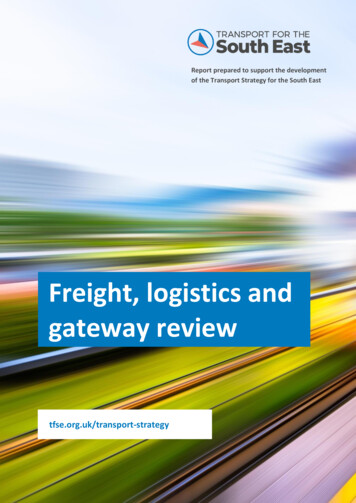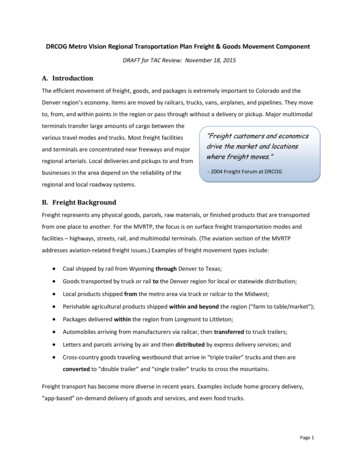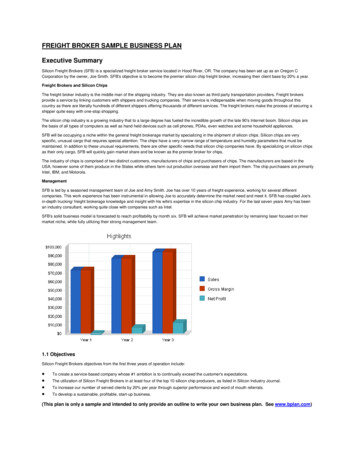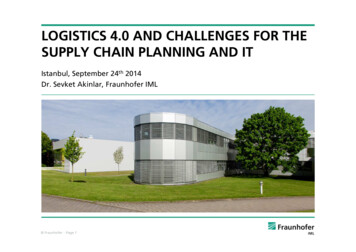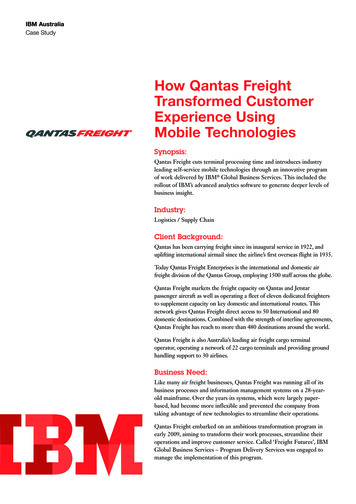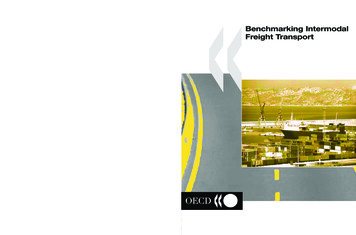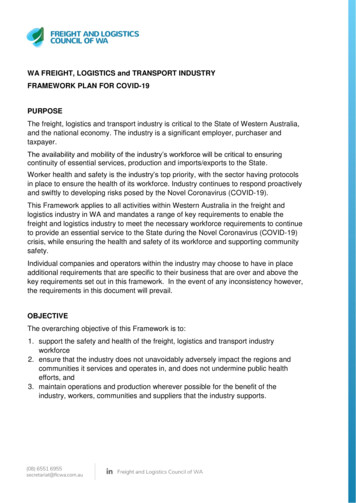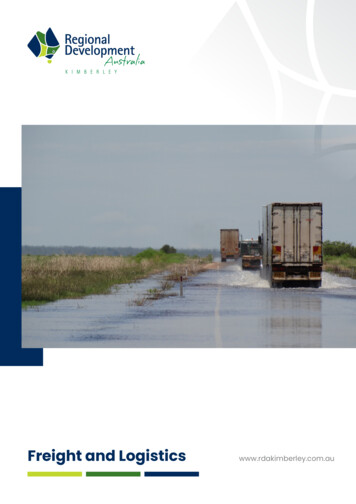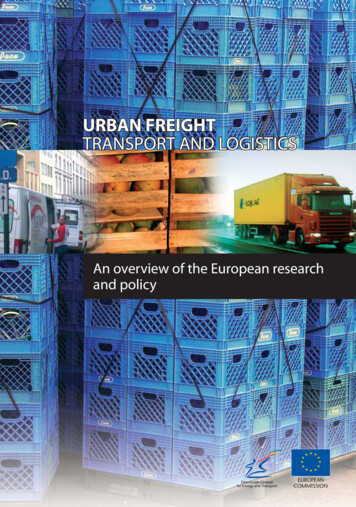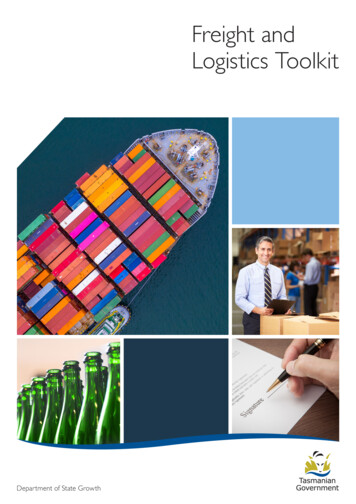
Transcription
Freight andLogistics ToolkitDepartment of State Growth
ContentsProduct packaging. 11Tasmanian freight and logistics overview.2Warehousing. 11Which mode is right for you?. 2Sea freight.4Domestic shipping services. 4International shipping services . 4What is Tasmanian Freight Equalisation and how does it apply to sea freight?. 6Air freight.8Does air freight get TFES?. 8Track your products. 11Storage capacity. 12Site suitability. 12Loading equipment. 12Identify assistance available. 12Work together. 12Freight 101 – Glossary of key terms.14Specific Incoterms.24Where are the Tasmanian air freight services located?. 8Register of Tasmanian transport businesses. 26Should I use air freight to transport my good to market?. 8TFES claims specialists.32Understanding air freight security protocols. 8Air freight into the future. 8Getting the best freight deal for your business/ understanding your freightsupply chain.9Your freight needs can change. 9Review costs and services. 9Copyright notice and disclaimerThis toolkit was developed by the Department of State Growth in collaboration with the Tasmanian Logistics Committee(Secretariat provided by Regional Development Australia (RDA) Tasmania) and the Tasmanian Transport Association.Export documentation. 9Import documentation.10Negotiate with freight operators.10Contract with freight operators.10Take control of your freight.10Track your pallets.10Know your customer.10Know your supply chain. 11Biosecurity. 11Reduce handling. 11Copyright in this publication is owned by the Crown in Right of Tasmania, represented by the Department of State Growth.Information in this publication is intended for general information only and does not constitute professional adviceand should not be relied upon as such. No representation or warranty is made as to the accuracy, reliability orcompleteness of any information in this publication. Readers should make their own enquiries and seek independentprofessional advice before acting on or relying upon any of the information provided.The Crown, its officers, employees and agents do not accept liability however arising, including liability for negligence,for any loss resulting from the use of or reliance upon information in this publication. Images used within thispublication remain the property of the copyright holder.Images courtesy of the Tasmanian Government and Simon de Salis. State of Tasmania March 2021
Tasmanian freight and logistics overviewAs an island state, Tasmanian trading businesses are reliant on freight and logistics to move goods off-island. Tasmania’sfreight system supports business and economic growth in the state, and freight and logistics options equip Tasmanianbusinesses to optimise growing national and international demand for Tasmanian products.Do you know how your product reaches its destination?It is important to understand the way your products travel. Different modes of transport offer a range of benefits.There may be more cost-effective options for your products than you currently have in place. The mode of transportused can also impact your eligibility for assistance programs such as the Tasmanian Freight Equalisation Scheme (TFES).Road freight options can be suited to carrying a range of products, including perishable, fragile or time-sensitive freight.Road freight can cater for just-in-time stock management, smaller inventories and door-to-door delivery. Road isalways utilised in the supply chain for Tasmanian businesses and is a useful link to sea, air and rail services.Air freight is often used by businesses to transport products interstate and internationally where time is a priority. Chilled seafood destined for Asian markets is both time sensitive, perishable and highvalue. Air freight offers a fast service for interstate transport and onto connectinginternational air services.Sea freight is the most common method used to transport products in and out of Tasmania and can be used for arange of products. For international markets, sea freight is often used for bulk and containerised freight, when time isa lesser issue, or utilised to link to international flights from Victoria or New South Wales.Rail can be a cost effective transport solution for regular, large volumes and long-haul cargoes, often used for heavybulk and containerised commodities, dense products and container loads of smaller parcels, where longer time framesfor transport can be accommodated.Example 1 Benefits – reduced travel time to market resulting in fresher produce and longershelf life. Disadvantages – higher cost and no Tasmanian Freight Equalisation Scheme (TFES)to reduce freight costs.Which mode is right for you?Consider: Lead time and preparation. Your product (its size and dimensions, and whether it is fragile, perishable or robust). The level of speed and flexibility you require. Your target destination and the transport options available to get there. If your shipment contains dangerous goods, or requires specialised permits, or is temperature sensitive.Example 2 You should discuss options and costs with a freight specialist. A register of Tasmanian transport businesses isavailable on page 26. Transporting wooden crates from Tasmania to Brisbane in a container. In thisinstance sea freight to Melbourne is likely to be the most suitable service out ofTasmania, with both rail and road services providing options for transport betweenMelbourne and Brisbane. Benefits – cheaper option to mainland with Tasmanian Freight Equalisation Scheme(TFES) to reduce freight costs for both domestic freight and overseas freight(containerised). Disadvantages – longer travel time to market.Example 3 Transporting seasonal fruit to China which is both time sensitive, perishable and highvalue. Intermodal transport options are generally utilised for this option, with coldchain logistics via road, sea freight, road again and then on to an international flight inMelbourne. Typically refrigerated container options suit this application. Benefits – cheaper option utilising the TFES. Disadvantages – may be supply chain issues with additional steps.23
Sea freightTasmanian Freight movements (major ports)As the only island state in Australia, Tasmania is heavily reliant on its shipping service to move the majority of freightacross Bass Strait to mainland and international destinations.Domestic shipping servicesThree main shippers provide a regular Bass Strait shipping service from the ports of Devonport and Burnie toMelbourne: Toll, Searoad and TT-Line, the latter being a Tasmanian Government Business Enterprise (GBE).Between these shippers, approximately 900 sailings occur annually between Melbourne and Tasmania (and return)with approximately 320 000 container movements (235 000 full and 85 000 empty). In addition, approximately65 000 wheeled unit (trailer) movements occur with 50 000 full trailers and 15 000 empty trailers.3.71 mtAlmost 99 per cent of Tasmania’s freight is carried by sea, with the remainder by air.1.36 mtThe majority of Tasmania’s sea freight is destined for domestic markets, with just over 11 per cent of freighttransshipped, primarily through Melbourne, for international export.BURNIEThe net outflows and inflows of freight are approximately the same and this substantiates the reliance Tasmania hason sea freight as a lifeline for its economy.1BELL BAYAdditional services are provided to King Island and the Furneaux Island Group to support remote communities.DEVONPORTInternational shipping services2.18 mtIn addition to the domestic services available, additional routes are also offered from time to time by internationalshippers – including MSC – that visit Tasmania.1.71 mt2.18 mtLaunceston1.05 mtThese carriers use Tasmania as a stop-off point and provide “feeder services” to international destinations via mainlandAustralia on periodic service arrangements.2Latest data from TasPorts Annual Report 2019-20 (mt million tonnes)0.81mt2019/20Import (mt)Export (mt)TotalBell Bay1.052.183.230.98 art0.980.811.79Major portsExportsImportsmt million tonnes12RDA Tasmania TFES Case Study Paper 2018RDA Tasmania Freight Equalisation Southbound (TLC) Case Studies Paper 201945
What is Tasmanian Freight Equalisation and how does it applyto sea freight?The Tasmanian Freight Equalisation Scheme (TFES) is an Australian Government initiative that provides financialassistance to eligible businesses to address the higher costs involved in moving products across Bass Strait by sea.Moving goods by ship across Bass Strait is more expensive than transporting the equivalent distance by road on themainland, therefore the scheme aims to reduce the difference in freight costs between these two different methods byproviding assistance on eligible freight shipments. Products moved by air are not eligible nor are goods shipped in bulkor are not containerised.How does the TFES work?The TFES is split into two key areas. Northbound movement of goods to mainland Australia and other markets(international) and Southbound movement of goods into Tasmania.NorthboundEligible Northbound movement of goods to mainland Australia include manufactured goods and products that haveundergone a production process or value add within Tasmania prior to shipment. Northbound movement of goodsto other markets need to transship through a mainland Australian port as part of their journey to their exportdestination to be eligible. Northbound assistance only supports the movement of goods from Tasmania to the pointof export on the mainland, it does not provide a subsidy for the export of the goods from Australia.In the case of Northbound TFES claims, only Australian registered entities can apply for TFES assistance with thepayments if they directly incur the cost of the freight. Payments are made in arrears on already paid invoices andare GST exclusive.Even if the supplier is based in Tasmania and the product has been sourced locally, it is still possible for a TFES claimas the supplier may simply be on-selling a mainland manufactured product. Not every item will be eligible. The basicground rules are that it needs to involve a Bass Strait movement by sea, be Australian made, or if imported, undergoa manufacturing process on the mainland first and relate directly to the Manufacturing, Mining or Primary Productionprocess. The construction of a building may not be eligible, but the machinery that goes inside it may be.Some exclusions include: Safety equipment or clothing is not eligible nor are fuels, oils and lubricants Any imported product shipped directly into Tasmania from overseas would not be eligible Products subject to an equalized National Pricing Policy would not be eligible as no disadvantage has been incurredby the Tasmanian client.King Island and Furneaux GroupAdditional assistance for intrastate sea freight shipped between King Island and Tasmania, and between Flinders Islandand Tasmania is also available through the TFES. This also includes shipments of freight between any island in theFurneaux Group and Tasmania.How can I make a claim for my business?A couple of options for Tasmanian business owners are available to take advantage of this scheme to offset eligiblefreight costs.These include:Register and make claim yourselfTo register your business, go ht-equalisation-scheme/make-claimUnlike the Northbound scheme, only Tasmanian based companies involved in Manufacturing, Mining or PrimaryIndustry can claim. In order to be classed as a Manufacturer, Miner or Primary Producer, the ANZSIC code whichforms part of the Australian Business Register listing must sit within these three categories.Any eligible claims will need to be accompanied by supporting documentation within 6 months of the date of shipment.It is the movement of goods across Bass Strait that attracts southbound assistance. The bigger, heavier, bulkier thegoods are, the more the freight component will be and the greater the assistance6Engage a claims specialistThe most popular option for many Tasmanian business owners is to engage a claims specialist to seek assistance ontheir behalf. Fees typically apply for this service.A list of TFES claims specialists is available on page 32.7
Air freightWhile the majority of freight movements occur by sea, air freight is an option for time critical or high value items thatneed to get to market in the shortest possible time. Typically seafood, cherries, flowers and other high value items areshipped using this method. Small quantity items are also usually transported by air freight.Getting the best freight deal for your business/understanding your freight supply chainDoes air freight get TFES?Moving goods from A to B remains one of the most significant costs any business incurs in day-to-day trading activities.Any strategy that assists in reducing freight costs is valuable as a means of improving business profitability and longterm sustainability.The Tasmanian Freight Equalisation Scheme does not apply to air freight movements, and the cost of using this servicewill normally be higher than sea freight.This list may provide a useful starting point to help your businesses improve or set up cost effective and efficient supplychains to transport your products.Where are the Tasmanian air freight services located?Your freight needs can changeThe major airports in Tasmania offer air freight services, with dedicated air freighter aircraft.As your business grows, your freight and logistics arrangements may need to change to continue to meet the needs ofyour products, customers, markets and the scale of your operation.Most passenger air services originating from smaller regional airports also provide additional cargo space for freightmovements. King Island and the Furneaux Island group have a heavy reliance on regional airlines to provide regulartransport of freight for the island populations.If you can plan ahead, you may avoid issues with capacity, seasonality and distribution. Reviewing and planning for yourfreight needs can support and promote business growth, rather than impede it.Should I use air freight to transport my good to market?Review costs and servicesWhen considering using air freight, two key factors will apply in any decision making:Review your business’s freight and supply chain costs at least once a year.1. Time – Are your goods time critical? If your answer is ‘Yes’ then air freight may be an option.Take the time to investigate how the rates paid by your business compare to the rates offered by other providers.This can help you to find out how competitive your freight costs are.2. Cost – Is paying a higher cost to use this service affordable for your business? Will your customers pay more for airfreighted goods? If your answer is ‘Yes’ then air freight may be an option.Understanding air freight security protocolsWhen sending air freight internationally, businesses should make themselves aware of security protocols and allow timefor mandatory screening. This process also has a cost factor that should be discussed with your freight forwarder inplanning shipments.Mandatory security screening is also expected to be implemented for domestic air freight in the future and businesseswould be wise to check with their freight forwarder regularly for changes to protocols.Air freight into the futureIn response to COVID-19, the Australian Government has introduced the International Freight Assistance Mechanism(IFAM) to keep key international freight links with trading partners open for goods coming into and going out of Australia.IFAM is a temporary, targeted, emergency measure to help Australian businesses deal with the COVID-19 crisis.The purpose of IFAM is to help support the efforts of businesses to re-establish key global supply chains disrupted byCOVID-19 (including in the agricultural, seafood and healthcare sectors)IFAM supports the aggregating of cargo loads, negotiation with airlines, working with partner governments to facilitateclearances, and improving transparency around freight costs during the pandemic.In addition to the IFAM scheme, during the COVID-19 pandemic, and to assist producers during the peak perishableproduction period, the Australian and Tasmanian Governments supported twice weekly flights to Sydney ex-Hobart toaccommodate additional exports of high value goods to international markets as a COVID-19 temporary relief measure.To find out more about IFAM, please click go to: t-assistancemechanism8If you are in a regional area, look at the freight operators delivering to your area. These trucks may be leaving emptyand may be able to offer more competitive rates.Export documentationExporters from Tasmania should be aware that certain countries and commodities carry specific documentation andimport requirements that need to be met. It is essential that thorough research is undertaken to determine whatdocumentation is required to sell your product internationally. It is the responsibility of the importer to supply thelatest information from their country to the exporter, as a country’s import documentation requirements can changevery quickly.Food and agricultural exporters need to consider phytosanitary requirements. Initial investigations can be made bylooking up your product and export country at www.micor.agriculture.gov.au, however, your freight forwarder shouldbe able to assist you further.A Certificate of Origin is a document that certifies the place of growth, production or manufacture of goods. Manyoverseas importers insist upon a Certificate of Origin when dealing with Australian exporters. Over the yearsCertificates of Origin have been refined to reflect specific importing country requirements. The Tasmanian Chamberof Commerce and Industry (www.tcci.com.au) is the Certificate of Origin provider in Tasmania.Some countries have other very specific documentation requirements – it is important to speak to your end customer,freight forwarder and/or an Austrade TradeStart advisor lp/Trade-services/TradeStart), as conditions can change quickly. Failure to correctly adhere to the documentationrequirements of destination countries can result in delays or even destruction of goods.The Incoterm used by an exporter is very important and may require the exporter to explore and understanddestination costs including duties, VAT, taxes, port costs and delivery costs. The Incoterm determines who (buyer orseller) pays for what costs and where the risk transfers. It is again recommended that a discussion with your freightforwarder and/or an Austrade TradeStart advisor take place early in your export considerations.9
Import documentationKnow your supply chainImporters into Australia should thoroughly check all aspects of the importation process, including the documentationrequired, prior to ordering any goods from overseas. As a baseline, importers should be able to provide a commercialinvoice, a packing list, a bill of lading, a packing declaration and a certificate of origin for goods arriving in Australia.Get to know your supply chain. Identify the steps and stops along the way to transport products to your customers.This will help you to find ways to move your products more efficiently and to identify savings.It is important that importers consult a customs broker prior to importing any goods to ascertain any specificprocesses or documentation that may be additionally required for clearing goods into the country. Importers should beaware of Biosecurity requirements and of ISPM15 packaging protocols, as failure to adhere to these requirements mayresult in additional costs or re-exportation or destruction of goods.BiosecurityAustralia enjoys Free Trade Agreements with many countries and importers are encouraged to discuss the specificsof Certificates of Origin with their customs broker to potentially benefit from duty free conditions.The emergence of invasive species in many countries has resulted in seasonal treatment requirements around certaingoods from certain countries – this can add costs to importation, and it is important to plan ahead with your customsbroker or freight forwarder to understand the processes and costs for the protection of our borders.Importers are advised to provide documentation relative to their shipments to their nominated customs broker assoon as possible once they have left the origin. Late documentation is the leading cause of storage and detention costson arrival in Australia, but these can be avoided with strict documentation timelines established early.Negotiate with freight operatorsTalk to freight operators about the rates and services they can offer you. Negotiating with providers can help you toget the best rates and make sure that your business’s needs are met.Do you use multiple freight operators to transport and handle your products? Consider offering your full freight needsto one operator. By increasing the volume and/or frequency of your deliveries with a single operator, you may receivea reduction in rates.Contract with freight operatorsIf you are regularly transporting products, consider entering into a contract with a freight operator. Contracted ratescan be a useful way to guarantee the availability of freight services at the level of service you require – and can alsooffer consistent and lower freight costs.Take control of your freightIt’s a good idea to be aware of and, where appropriate, manage your business’s freight arrangements and costs – evenfor products that are bought and distributed by a third party. This is important to ensure that your customers aren’tpaying unnecessarily high freight costs when they purchase your products.Track your palletsReplacing lost pallets can add to your business’s freight costs. Implementing a pallet management system may help youkeep help track of your pallets.Know your customerConsider your customer’s packaging and logistics needs. Do they require products in small containers that can be easilyhandled? Can their site be accessed by a large truck? It can be useful to establish your customer’s needs and workbackwards to develop your supply chain.10With a significant volume of goods moving into and out of Tasmania, biosecurity plays a crucial role in ensuring pests,diseases and weeds do not arrive in Tasmania and threaten native vegetation, wildlife and local crops. The responsibleagency for Biosecurity in Tasmania is the Department of Primary Industry, Parks, Water and the Environment(DPIPWE).All containerised and some bulk freight entering or leaving Tasmania must be certified pest and disease free. Thisinvolves regular inspections of shipments and also fumigation of containers to eradicate any pests. Typically BiosecurityTasmania will charge a fee for this service.The main considerations when preparing freight for shipment or receiving inbound freight include:1.Acting responsibly – this includes understanding biosecurity requirements and ensuring all regulatory protocolsand compliance procedures are adhered to. This includes taking direction from appointed biosecurity officers.2. Reporting – including the reporting of any anomalies or irregularities to Biosecurity Tasmania so that the requiredmeasures can be implemented.Biosecurity measures are vital to protect our primary industries, the Tasmanian brand and the natural environment.Biosecurity measures aim to protect lives and livelihoods from pests and diseases such as fruit fly, foxes and other threats.To find out more, click on this link: www.dpipwe.tas.gov.au/Documents/Tas Biosec System beginnersguide.pdfReduce handlingHandling – such as packing, loading, unloading – are necessary steps when moving your products from one place toanother. They can also be expensive. Look at your supply chain. Could you reduce the number of stops and handlinginvolved in moving your product? By reducing handling you may be able to prevent delays, reduce costs and limit thechance of damage during transit.Product packagingPackaging is important for the presentation and protection of your products. It can also be used to improve handlingand the use of space during storage and transit. Does your packaging allow you to use all of the available space onpallets or containers for transport? Sometimes a small change in the shape or dimension of packaging can enable moreproducts to fit into the same space. Using all of the space available can reduce freight costs and limit the chance ofdamage during transit.Track your productsDo you know where your product is? Consider if tracking is important t
chain logistics via road, sea freight, road again and then on to an international flight in Melbourne. Typically refrigerated container options suit this application. Benefits - cheaper option utilising the TFES. Disadvantages - may be supply chain issues with additional steps. Tasmanian freight and logistics overview
